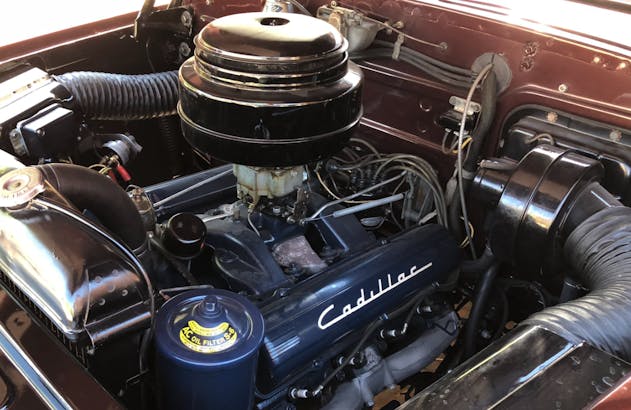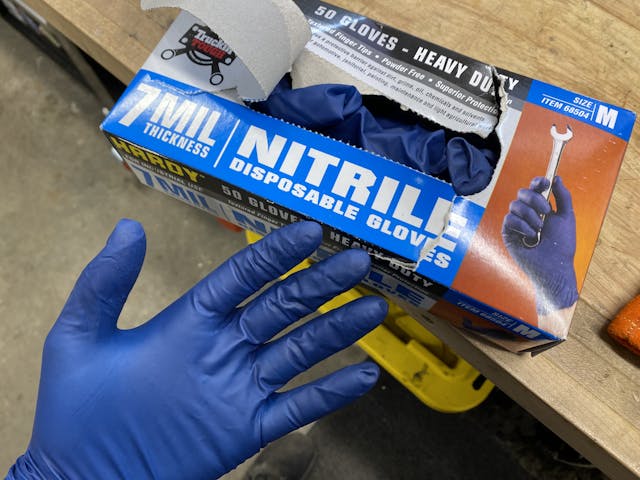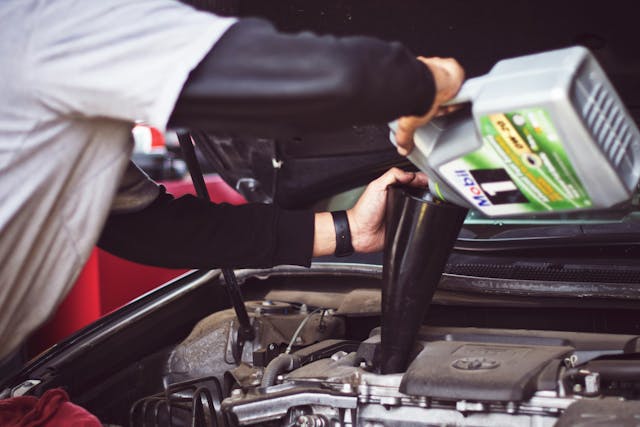8 oil change dos and don’ts
It’s a small job that somehow became a rite of passage for gearheads: Oil changes. The draining and refilling of engine oil is the first task that many budding wrench-turners undertake, and its certainly an important one. Like any other task in the automotive world, there are some pieces of institutional knowledge that comprise the key dos and don’ts for a smooth oil change. So let’s put these lessons learned out in the open, with the mission of shortening the process for newbies. And perhaps to reinforce some best practices for you veteran mechanics?
Don’t go crazy with warm-up

Modern oils are pretty amazing at suspending particles and contaminants, but there is still some junk that sinks down to the bottom of the pan. It needs to be stirred up to ensure it escapes when you pull the drain plug. Starting the engine and letting it idle for a minute or two is perfect for that final circulation. Run it any longer and you’re rewarded with nothing more than scalding hot oil that does nothing more than burn you. Before you pull that (drain) plug, give the engine a minute after shutting down, allowing the oil to drain to the pan from the nooks and crannies higher in the engine. But before you get underneath the vehicle to do the deed, remember you must…
Wear disposable gloves

Nitrile gloves keep you from soaking up solvents and oils into your skin. I’ve found 7mil thick to be a nice sweet spot of durable and affordable.
We all know the guy at the auto parts counter who has seriously gnarly hands from all the years being soaked in oil over decades of engine builds. That’s the visible damage. The invisible damage is sitting in your internal organs. All the hydrocarbons that get absorbed through the skin and are processed in our gut where they can’t be broken down. They end up accumulating in our body, which can cause serious health complications after years and years of chemical exposure. Preventing those issues is easy as putting on a pair of nitrile gloves. Use them even if it’s only for pulling the filter and drain plug, which you can do efficiently with…
The drain plug trick

It’s not groundbreaking, but nothing feels better than the perfect pull on a drain plug to ensure you don’t get any oil on your hand. The trick is pressure, not pulling. As you unthread the plug by hand, push in–against the bolt as in comes out–so the threads act as a seal with the outer edge. With a little practice you can get the pressure right (while not rocking the plug in the threads) and can spin the plug a full turn to feel for the “click.” That click means the bolt overlapped the last thread. With a swift motion away from the direction of oil flow, remove that now-loose plug. Presto! This can make thin viscosity oil changes much cleaner, and thick stuff like 20-50 can sometimes be spotless. In your excitement of not having a mess to clean up after draining, make sure you…
Don’t over tighten the drain plug or filter

It’s come to the point where stuck filters and stripped drain plugs are no longer a joke. Neither the filter nor plug require any real torque when installed properly. Use a small amount of oil to lube the filter’s rubber seal, then spin it into place. After the gasket seats on the housing, turn it only about three-quarter of an additional turn. Some applications might call for a full turn, but that is usually reserved for heavy duty equipment. Any tighter than what the filter manufacturers call for and you run the risk of deforming that rubber seal, which could cause oil to leak past the seal. That’s bad news. Any oil spillage is bad, so when you are filling…
Just use a funnel

The oil fill port on most engines is in that perfect spot where it looks like you could pour directly into it, except that’s a lie. They seem to be ideally located, but cleaning up if you miss (by even the smallest margin) can be a major pain. Are we really going to work so hard to spot and address leaks, to keep our engines clean, and just ruin it while doing routine maintenance?
I’m not. A funnel all but guarantees I won’t have to do any clean up after filling, even if I’m distracted or letting my 7 year-old niece do the filling. Putting in that fresh oil feels good, but be careful and…
Don’t overfill

This shows the rotating assembly without the oil pan and it’s easy to tell how oil at too high of a level would be bad.
Too much oil is just as bad as not enough. Seriously. The oil level in a wet-sump engine is carefully calculated to keep the rotating assembly from whipping through the oil. That action causes foaming, and oil foam pushed through the oiling system is the same as not having oil at all. I don’t need to tell you how bad that can be, so check the service or owners manual for the proper fill level. When done, look at the dipstick as a double check. Luckily, the empty oil containers you now have at this point are are perfect to…
Recycle your used oil

It’s never been easier to properly recycle used oil, so there is no excuse to do otherwise. Just about any auto parts store takes it, so they should be your first trip in your freshly serviced vehicle to “return” your oil. Be sure to capture oil in a non-contaminated pan so that the oil can actually be recycled. Coolant is the main enemy here, so be sure to flush your drain pan before the oil change. Luckily you don’t have to worry about how dusty or dirty the pan is, but other fluids can defeat the purpose of recycling. But before you make the trip to recycle the oil, be sure to…
Reset the computer (or write down your service date)

Modern cars have an oil life monitoring system. Whether you trust it is a personal preference, but for the sake of eliminating confusion, go ahead and reset it now. Most reset procedures involves cycling the ignition key and pressing the throttle pedal a certain number of times. The service manual will outline it, or a quick search to an online make/model specific forum will have the instructions. If your vehicles are of the manual variety, write down the oil change date in a log book. Or consider service tracker kept in the car or garage, as it keeps you from forgetting what’s been done. Not to mention thisa paper trail shows good stewardship to a potential next owner, which can mean an easier sale for more money.
In all, oil changes can be simple and rewarding for newbies and DIY enthusiasts alike. Following these best practices will not only keep your vehicle happy, but also make the experience better for you each time. Do you have something specific you add to this process? Let us know about it in the comments below.
***
Check out the Hagerty Media homepage so you don’t miss a single story, or better yet, bookmark it. To get our best stories delivered right to your inbox, subscribe to our newsletters.



Bless you for writing this as “Dos and Don’ts”. That is all.
The number one rule for changing your oil is to never run your engine with out oil. Never forget to put the drain plug back in. I used to think that the best way to change oil was to drain it first to allow time for the oil to drain out while I changed the oil filter and lubed the front end to give the oil plenty of time to completely drain out. Now that I am older I realize it does not matter if I leave a little dirty oil in the engine. Now I wait for most of the oil to drain out and immediately put the drain plug back in.
Those are all good tips. Here is one more. Always pour the fluids with the spout to the top of the container to help avoid spills and prevent “glugging”. The photo in the article has it the right way. If you look at the bottle many even have the little international symbol on the neck, like the cigarette lighter or the wiper knob.
Surprised no one has mentioned a magnetized drain plug.
I write the date and milage on the bottom of the filter before installing it. Not mentioned in the article, but important is to fill the filter with fresh oil before installation, if possible
You did not touch on the most important part. Set yourself up for success not failure Do NOT reinstall the oil plug until you are ready to tighten it. Seems simple enough but being in the towing business, I can’t count how many vehicles we towed because of this mishap
A lot of “practices” are subjective; not necessarily personally, but scientifically as well. Oil change intervals can vary drastically between engines, and the type of driving done. Manufacturers (oil and vehicle) have a bazillion reasons for the specifications they recommend, but it’s ultimately based on things like -the type of driving and frequency; the quality of the filter used; the age of the engine (overall as well as post-overhaul); environmental conditions ; environmental considerations/concerns. A good quality oil and filter will keep the innards cleaner over-all, and reduce the rate of breakdown and contamination. I’m not going to make any specific recommendation of frequency and wouldn’t feel comfortable doing so.
One thing about reusable air filters is the use of oil. Don’t use too much and don’t use too little. Watch out for off brands making exceptional claims – cheap parts are EVERYWHERE. You can get a pretty darn good idea of how efficient they are by cleaning them regularly and having a peek down inside when you service them (sometimes easier than others). Let’s not forget that the primary selling-point for these things is air-flow and “performance,” not necessarily efficacy.
I find that holding the pan up as high as possible below the sump pretty much guarantees a spill-free operation – it’s not that heavy while it’s still empty. And yes, try to avoid windy days (although it seems a sudden gust will inevitably come round at the exact wrong time).
And, maybe most importantly, this article was presumably not designed to be the quintessential guide, but reinforce a hand-full of basic good practices. Here I am getting pedantic. Sorry, everyone.
And why does the breeze always turn into gale force winds to blow the oil flow all over!! Lol
I had a coworker with a 318 (I believe) 1978 or so Dodge Diplomat. It was a beater car and as an experiment, he refused to change the oil, ever. Last I heard, it had 165,000 miles on it and he got several more years out of it before he scrapped it out due to rust.
Ray, my late brother-in-law, machinist by trade, drag racer by avocation, Never changed the oil on his late 70’s Blazer. He figured at 100k miles, oil changes at the service shop would be about $1900.00 total and he could get the shop to replace the 350″ motor for that amount. Think he didn’t factor in inflation.
If you have air ride suspension, turn it off before jacking up the front end. As I learned years ago on my 88 Lincoln Mark 7 LSC, when you let it down, it goes down and you’re left with the jack stuck underneath
Another Tip: Changing your oil more often is better than changing it too late. On my daily drivers especially, I go to about 5000-6000 miles, even when the Oil timer says otherwise, usually around 30-50% life left. Also use the proper oil for your car, for example if you have an older car, use the oil with zinc. Understand the difference between Full Synthetic and Conventional and which cars you should use each.
My father taught me before draining the oil to open hood remove oil filler cap and put it where the hood pin latches that way if you get interrupted will servicing the car you won’t forget to put oil in engine because you won’t be able to close the hood
Your dad is a smart man. I taught the same method to my 3 children and thousands of high school automotive students.
In Canada we can put used oil out with the recycle cans and paper etc. I put it in the same plastic container it came in and mark it “used regular oil or synthetic with a magic marker. They will also take old batteries or anti freeze. They put it in large containers back at the yard. No excuse now for dumping stuff down the storm drain in the street and ending up in the river anymore.
We don’t have used oil and car battery pickup in the greater Toronto area.
There is no excuse, ever to dump used oil down a storm drain. Even if you are american.
I did the drain plug trick on my boat. It’s an in-line 6 cylinder Chevvy. It’s too low in the bilge to get a pan under and impossible to get one out as well. I used a garbage bag to collect it a few times but still had a mess. I drilled the plug and tapped it with a 1/4” pipe tap and installed a nipple and ball valve. Now I fish a piece os garden hose through the bilge drain an attach it to the valve and drain the crank case into a pail out the back of the boat. Oh yes, I also put a plug in the ball valve after in case of an accidental opening.
No fuss no mess.
My first post is above. I didn’t realize the reply was not to a specific post. Mine was in reference to Mr Osborne’s gasket tip. As later posts said, you only forget once!